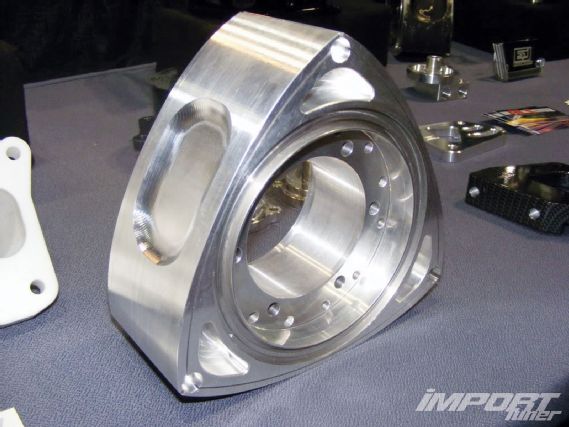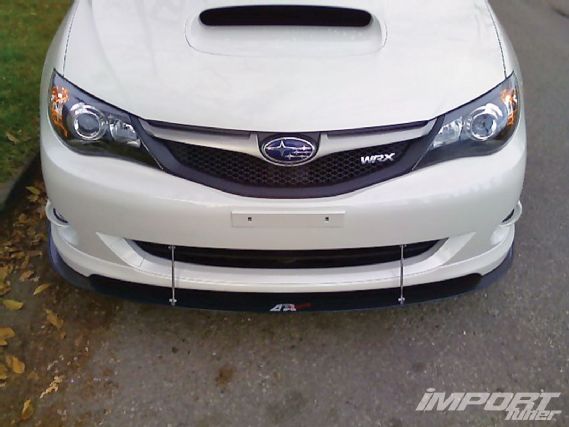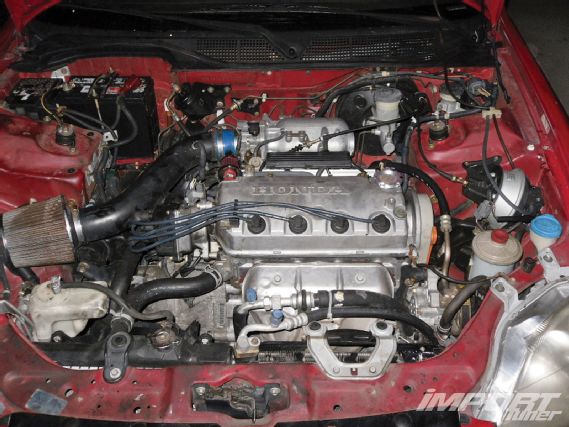 | Rotary Engine Upgrades and More - Question It
| Rotary Engine Upgrades and More - Question It
Got a burning question or simply need some advice with problems you’ve encountered while wrenching on your current/future projects? Ask our automotive guru Eric Hsu anything—literally, he’s going to answer every single question, as long as it’s automotive related.
Got a tech question?
Send it to
questionit@importtuner.com
Scared Straight
I grew up around big domestics my entire life. I eventually fell into the tuner world after buying a ’90 VW Golf as my very first car and now crave something different, wild, and exotic with my sight set on a ’92 RX-7 with the 13B rotary engine. The current owner says it belonged to his son who has since gotten bored of the car and left it with his father to sell while he goes to school. He says he doesn’t know much about the car other then the fact that it has over 100K, runs smooth, and keeps it stored in a garage. Realizing the uniqueness of the rotary engine, why does everyone seem so scared to tune it? I can’t seem to find any technical information about them and the only people willing to talk about them are forum guys. I’m finding it impossible to believe anyone online after one guy told me to replace the headlight fuse that kept blowing with a paper clip. In reality, it ended up being a loose wire that was shorting out. I would also like to know what kind of power modifications I could make with a budget of $6-8K. I would like to do as much of the modifications myself, but I know I can’t do everything. Any help would be appreciated.
 |
Rotary Engine Upgrades and More - Question It
|
Rotary Engine Upgrades and More - Question It
-Michael Rafuse
Kingston, Ontario, Canada
Once upon a time, there was a media form called a book. Words were printed on pages made of fiber from trees not dissimilar from scrolls written on papyrus. In fact, books were almost like a series of bound scrolls. Yeah, but seriously, to learn the fundamentals of anything, I still refer people to books. Why? In this day and age, the Internet isn’t the most reliable source of reference (like you’ve discovered firsthand). Sometimes the Internet has good information, but sometimes it’s the blind leading the blind. You’ll need to take whatever you read on the web with a grain of salt.
The rotary engine itself has remained mostly unchanged over the last 40 years, so a book published on the rotary engine even 20 years ago wouldn’t be too far off the mark. While you’ll have to excuse the books for their ancient references to carburetors, all of the information an old book offers regarding the engine itself, the maintenance, modifications, and the care of the cars and engines still remain valid. People are quick to dismiss books simply because they “aren’t up to date”, but one of the most widely used automotive engineering handbooks, the Bosch Automotive Handbook, was first published in 1932.
Try the Mazda RX-7 Performance Handbook by Mike Ancas for a starting point. Many of the rotary books I read in my youth are unfortunately no longer in print. Try perusing through some used bookstores, and I’m sure you’ll find books on Mazdas and rotaries. Before you start modifying any car, it’s good to understand the principles of the engine itself.
As for modifying an FC RX-7 for $8K, I’d recommend a turbo-back exhaust and unfortunately this is where most of your money will be spent, a Haltech stand-alone Platinum 1000 ECU with a plug-in adapter harness, a front-mount intercooler, and professional dyno tuning. Unfortunately, there aren’t any cheap ECU solutions for the early RX-7s. Or if you want to give the tuning a try yourself, read up on fuel injection and learn or sign up for an EFI 101 class at EFI University (efi101.com). Tuning a rotary is just like tuning any other engine, although you’ll need to be extra careful since the apex seals in a rotary are very sensitive to detonation.
Valvetrain Basics
I am currently in the midst of a very extensive engine build that has little to no aftermarket valvespring specification support. How exact do valvespring tolerances have to be? I have collected nothing but custom parts to properly build my Mitsubishi 6G75 engine, but have hit a roadblock when it comes to valvesprings. I’ve had multiple nationally known shops and manufacturers of valvesprings spec these springs and come up with nothing. No manufacturer is willing to do custom one-off springs without a 2,000-piece minimum order so I’m all out of options. I’m not sure if it’s the spring diameter, heights, or coil bind that’s preventing me from completing this build, but I would think if I can get a few of them correct and make some minor adjustment to the heads or a custom seat and retainer, we could make something work but I have yet to find a solution for the past seven months.
-Thomas Drake
Davie, FL
There are several factors to consider when determining a valvespring to fit in your head: installed heights, seat pressure, open pressure, outside diameter, inside diameter, and coil bind height. There are actually more factors to properly design a valvespring, but it sounds like you’ll be happy just to find something that could work so we’ll skip the discussion on a spring’s natural frequency and stress. The installed height is the height between the spring’s lower seat and the bottom of the spring retainer when the valve is closed. The spring’s inside diameter will affect how the spring is located. You may have to machine custom retainers if you cannot find a spring to work with your factory retainers. Or if the spring is located from the bottom seat, then you’ll just need to find a spring with an outside diameter that will fit in the head and that is not larger than the factory retainer. A spring must be located with the spring seat, the retainer, or both. Once you have an idea of the dimensions that the spring must be close to, then you can find a spring with the seat pressure and open pressures you or your cam designer wants. The seat pressure is the amount of force that the spring puts on the retainer at the installed height. The open pressure is the amount of force that the spring puts on the retainer when the valve is at xxx inches of lift (ask your cam designer what xxx needs to be). This paragraph probably isn’t going to help you too much, but hopefully it explains the basic information that you or your cam designer needs to gather. Once you have this information, I recommend you check out the Eibach EVS, Ferrea, and Manley valvespring catalogs for a massive range of springs you can choose from. I cannot suggest seat or open pressures for you since I know nothing about your valvetrain mass or cam profile, but your cam supplier or grinder should be able to help you out with that information. But my question is: Why hasn’t he already helped you with this?
While some people enjoy this, wouldn’t you be having more fun just beating the crap out of an EVO? This is an example of one of the reasons why I always tell people it’s easier to modify a platform that everybody else has already done. When the average guy tries to reinvent the wheel, the result is usually an uphill battle that requires a lot of time and money being spent for far less reward. There’s a reason why everybody builds EVOs: There’s a ton of parts support and the results are usually pretty damn good.
Roasting The Clown
I received the Nov. ’11 issue in the mail and saw you guys posted my stupid question. I don’t even remember sending it. Prior to seeing Eric’s response, I did my research instead of being lazy and sending more stupid emails. Thanks for the smack in the face; I definitely deserved it. Stupid questions get stupid answers! At least I got my 15 minutes of “I’m stupid” fame printed in a worldwide magazine. Sorry to the great Mr. Hsu for answering my retarded question. I can’t wait to get crap from my people. Keep up the great work guys.
Your stupid question fan,
-Wil Anderson
Richmond, VA
(Original Question)
Trans Conversion
I own a ’92 Integra LS auto, and it’s become my new project since I decided to total my ’99 GSR. I’ve managed to pull everything off the GSR for a swap. When going from an auto to manual conversion, what would be the best pedal assembly for my ’92 LS? The DC2’s trans was a hydro, but it will be converted over to a cable. Which leads to my next question. What is best clutch cable for this application? I want to do this the right way the first time, being an import geek for the last 13 years I’ve learned my lessons on not taking the shortest route.
-Will Anderson
Richmond, VA
Well let’s see . . . how about a clutch pedal assembly and cable from a ’92 Integra LS? You’ve been playing with imports for 13 years, but couldn’t figure that one out? I’m not sure if these questions are getting filtered enough. Scott, WTF?!
Winter Wonderland
I own a ’09 WRX Premium (or 265 in Canada) sedan. I wanted to improve the vehicle’s handling. I live in Edmonton, Alberta, Canada, where the winters are serious. Even in spring and summer our roads suck and a low ride height can be problematic. Basing my decision on long-term durability, I chose to install a Perrin sway bar and endlink combo and strut bar. Due to increased bumpsteer I followed it up with a Perrin anti-lift kit and a 3-inch caster (alignment at a reputable shop). The car feels great when being pushed, but ride quality has suffered more than I had planned. I have seen GTSpec bumpsteer kits advertised. Would the bumpsteer kit with rubber OEM bushing in my control arms help bumpsteer and allow me the same confidence in corners with more ride quality? If not, what would you recommend for occasional track days and crappy daily driven roads?
 |
Rotary Engine Upgrades and More - Question It
|
Rotary Engine Upgrades and More - Question It
-Chris
Edmonton, Alberta, Canada
Bumpsteer is something that happens when the steering rack or tie rods are setup incorrectly either due to the car being lowered or raised. Bumpsteer is a drastic change in toe throughout the suspension’s travel that causes a loss of traction and directional instability. It usually doesn’t affect ride quality except in extreme cases. It does, however, affect stability and traction.
The main purpose of an anti-lift kit isn’t to improve ride quality or decrease bumpsteer; it is to keep the front end from lifting during hard acceleration improving front traction. I’m not sure what you mean by “3” caster, since caster is usually measured in degrees, but increasing caster on a all-wheel-drive car usually helps to increase turn in grip and steering feel.
You didn’t mention if you actually kept the car’s ride height stock or if you changed the springs and/or dampers.
Deciphering your paragraph, it looks like your question really seems to be two questions: 1) How can you keep the ride quality good while further improving the car’s handling? 2) Would a bumpsteer kit with OEM bushings help to improve the car’s handling?
The answer to the first question is enough to fill several chapters in a book, but I’ll try to summarize and answer both. It is possible that your new sway bar is too large or stiff, especially if you are running stock dampers and springs. You might try a smaller-diameter bar if that’s the case. Whiteline has multiple sway bar sizes so I’d recommend a visit to their website. Unfortunately, a bar’s diameter is really only an indication of its size. Bars of the same diameter from different brands, but made of different material or that use a different heat-treat process (if any), can react completely different on your car. The anti-lift kit and increased caster are good modifications. If your car isn’t lowered or raised much, then I’m not sure if a bumpsteer kit is completely necessary. If the car is at or near the stock ride height, chances are you don’t have much of a bumpsteer issue. Different dampers and springs can actually increase both ride quality and handling, but unfortunately “ride quality” is a subjective thing so there’s really no other way to discover a damper and spring combo that you like without driving a car with the same setup yourself. Many of the higher-end suspensions (e.g. KW, Moton, Ohlins, AST, and more) actually ride much better than stock while handling better at the same time.
Overall, you need to speak to an experienced suspension shop, like Robispec, to help you get to your goal. There are a million websites that sell catalogs of parts, but it’s the experienced shops that can tell you exactly what you need for your application.
Horsepower Junky
I own an ’00 Honda Civic with a MagnaFlow cat-back exhaust, K&N air filter, and a performance chip. I was thinking about bumping the compression ratio from 9.4:1 to approx 10.2:1 like the Civic Si. Are there any drawbacks to increasing the compression ratio, and how much would that help increase the power? Also, what would you recommend as a next step to make more power?
 |
Rotary Engine Upgrades and More - Question It
|
Rotary Engine Upgrades and More - Question It
-Mitch Canfield,
via importtuner.com
Increasing the compression ratio a large amount like you mention can only be accomplished by changing pistons and/or milling the head’s fire face. Both of these methods are fairly expensive for the returns in power. To change the pistons, you will need a set of forged pistons, piston rings, every gasket seal, and O-ring involved with rebuilding the engine. Plus you’ll need to actually rebuild the engine itself, which can be costly if you don’t know how to do it yourself. To mill the head, you’ll need to remove the head, measure the valve-to-piston clearance at various crankshaft angles (and cam angles if you have a variable valve timing engine), take the head to a machine shop for milling, degree the cams during reassembly, and use a new head gasket. While increasing the compression ratio is a good way to increase torque, engine response, and power, it is expensive and requires high-octane fuel. Why not go for a header, performance camshaft, lightweight flywheel, drive crank pulleys, and a Hondata ECU instead? Increasing an engine’s efficiency can go a long way for both output and fuel consumption. You’ll probably end up with the same or more power as increasing the compression ratio without the trouble and expense. Plus, you can remove the parts and sell them in case you want to sell the car one day.
